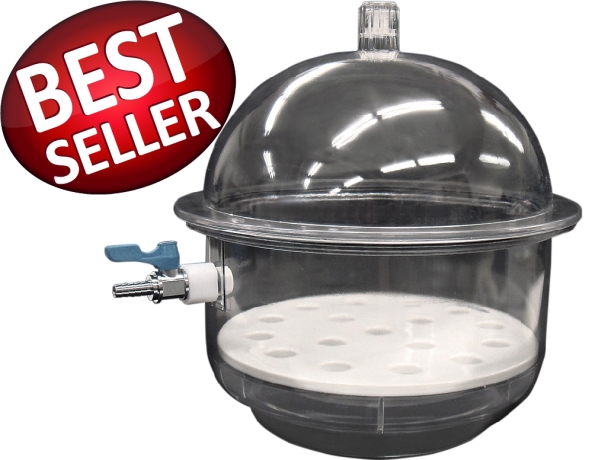Desiccators are containers made of plastic, glass or metal, for the purpose of storage and final drying of solids, to isolate external moisture in laboratories. Desiccators are an economical and reliable way to maintain dry (and dust-free) storage of moisture-sensitive parts and products.In the fields of electronics, pharmaceuticals, optics, metal, archeology, collectibles and museums. Basically, it is not used to dry material, but maintain a dry material in a dry environment.In each laboratory you can find a plastic or glass desiccator, round or rectangular for storage in dry cells of materials and parts.
A number of sizes and shapes are available.
MRC represents "sanpcatec" in its products Desiccators.
Questions to ask when purchasing a round desiccator:
-The larger the diameter, the larger the volume of work. There are desiccators from diameter 150 mm to 300 mm.
- Will the desiccator be used to create a vacuum? In this case a tube vacuum is needed.
-Pyrex desiccator or polycarbonate desiccator? In the Pyrex desiccator you can place hot parts that have been removed from the oven.
-Sealing by sealing rubber (O RING) or by silicone grease.
-Is there a need for a vacuum clock that will show from a vacuum the depth in the desiccator?
- Is a vacuum pump needed?
What is the purpose of a desiccator?
The main purpose is to keep moisture low using a desiccant.A desiccator protects moisture-sensitive items
What are the uses of a desiccator in the lab?
A desiccator helps chemicals not get wet, and it helps any chemical stay dry all day.
Vacuum Desiccator
A laboratory round vacuum desiccator is a sealed round container used to store and protect items that are sensitive to humidity.
It typically consists of a clear dome or lid and a base, with a valve for evacuating the air inside to create a vacuum.
The primary use of a vacuum desiccator is to maintain a low level of humidity inside the container, which helps to preserve the integrity of moisture-sensitive materials such as chemicals, biological samples, and electronic components. They are commonly used in laboratory settings to store and protect samples, instruments, and other equipment.
Types of Vacuum Desiccators
There are two main types of materials used to make laboratory round vacuum desiccators: Pyrex and acrylic.
Pyrex desiccators are made from borosilicate glass, which is known for its high resistance to thermal shock and chemical attack. They are often preferred for high temperature applications, but can be more fragile than acrylic desiccators.

Acrylic desiccators are made from a type of plastic known as polymethyl methacrylate (PMMA). They are more durable and less expensive than Pyrex desiccators, but are not as heat-resistant.

Sanpcatec Instrument
Sanpcatec is the biggest manufacturer in Japan and one of the biggest manufacturers of Desiccators in the world.
Some facts about Sanpcatec:
Sanpcatec instrument Is a leading company of laboratory plasticware in japan.
Sanplatec Corporation is a Japan-based company founded in 1964

Choosing the Right Desiccator
Size and Capacity Considerations
When selecting a desiccator, size and capacity must be considered based on the materials to be stored and the available space.
Material of Construction
Desiccators can be made of glass, plastic, or metal. The material you choose depends on the specific application and level of durability needed.
Level of Vacuum or Sealing Required
Depending on the application, you may require a desiccator with a high vacuum or an airtight seal to ensure optimal performance.
Desiccant Materials Used in Desiccators
Silica Gel
A common choice for desiccants, silica gel is affordable and effective in absorbing moisture.
Molecular Sieves
These are advanced desiccants that offer superior moisture absorption capabilities, often used in high-precision applications.
Activated Alumina
Activated alumina is another effective desiccant, particularly suitable for gas and air drying applications.
Calcium Sulfate
Known for its excellent moisture-absorbing properties, calcium sulfate is often used in industrial desiccators.